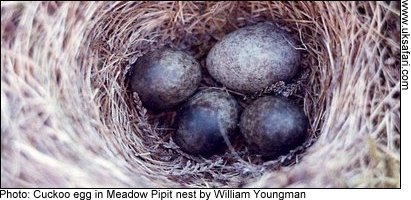
The custom of giving eggs at Easter time has been with us for thousands of years. It's been traced back to early civilisations which considered the egg to be a symbol of life. But did you know this egg giving tradition is practised by the birds in your garden?
It would take some stretch of the imagination to make comparisons between a cuckoo and the Easter bunny, but in terms of job description, the cuckoo does deliver Easter eggs.
How does a Cuckoo know Where to lay it's Eggs?
Cuckoos are very good bird watchers. They have to be in order to know which species of bird are capable of raising their young, and which species of bird will feed their chicks suitable food. They also watch other birds in order to know exactly when to place their eggs in another birds nest. If it's put in a nest where the other eggs will hatch first, the cuckoo's egg might be damaged by the movements of the other chicks. Ideally the foster mother will have just started laying her own eggs when the cuckoo drops her egg in the nest.
The cuckoo will only lay one egg in each nest. Two or more cuckoo eggs would be more noticeable. Where this does occur it is usually the work of more than one cuckoo. For the poor foster parent this must be like lightning striking in the same place twice.
Quick Growing
The cuckoos egg will usually hatch out one or two days before the rest of the eggs. Within twenty four hours it is growing with astonishing speed, and soon starts to realise that there will be no room for others in the nest. The foster parents will have a tough job satisfying its appetite, so almost instinctively it begins to eject the other chicks and eggs.
Within three weeks the young bird will be fully feathered and about ready for its first flight. Since it will now be much larger than the parent it will have already left the nest... if the nest hasn't already been crushed under its weight.
